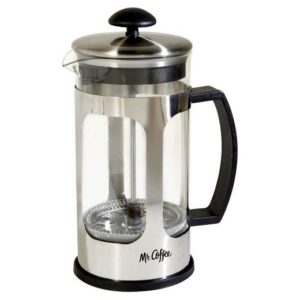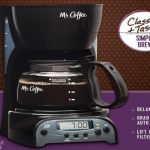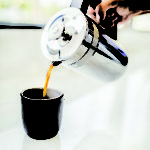French Presses Review: Mr. Coffee Coffee Press
A budget French press that does the job, but just barely.
 Mr. Coffee 1.1 Quart Black Coffee Press
Mr. Coffee 1.1 Quart Black Coffee Press
Mr. Coffee, of course, is better known for its automatic drip coffee machines than for its manual brewing devices. Were it not for the fact that a branded French press is practically a compulsory addition to the catalog of any housewares brand that dabbles in gear for warm drinks, it would be a surprise that Mr. Coffee, the company that revolutionized the coffee industry with the original auto-drip home coffee machine in 1972, would issue a French press at all. It’s less surprising to note that Mr. Coffee also, for a time, sold an electric French press. What’s not surprising is that, as the company today seems to hang its hat on inexpensive appliances for the budget-minded shopper, the construction of its low-cost press pot is not the best.
Which raises the question: For a method as straightforward as French-press brewing, how fancy does the equipment really need to be? A French press only needs to accomplish two things, after all: hold hot water and filter out the grounds. The Mr. Coffee Coffee Press proves that, to some degree, a workable French press can be had for a very modest investment.
In our tests, the Mr. Coffee carafe’s heat retention proved to be on par with that of the glass carafe of the well-respected and higher-priced Bodum Chambord. In fact, it performed slightly better in some respects. After the carafe was preheated for a minute with freshly boiled water, 600 grams of 205-degree-Fahrenheit fresh water added to the Mr. Coffee dropped, on average, to 199 degrees within the first 30 seconds, a better performance than the Chambord by about two degrees. By the end of five total minutes, the temperature descended another 16 degrees, a rate of decline that positions the Mr. Coffee squarely in the middle of the pack among the five presses we tested.
While this performance is commendable, trouble sets in with the filter. The mesh of the Mr. Coffee filter system is visibly wider than the mesh in other press pots, allowing more than the average amount of silt to pass into the cup. An abundance of particulate mixed into the finished brew can produce bitterness at worst, simple muddling of flavors at best. True, cup clarity and flavor articulation were never virtues of a characteristic French-press brew. Nevertheless, coffee drinkers who love a full-bodied brew but are wary of too muddy a cup might consider seeking a press pot with a more effective filter.
The base-plate of the filter system is also of noticeably low quality, constructed of thin, slightly warped metal with channels pressed into it. The threading at the bottom of the rod is imprecise, causing an occasional challenge in getting it started back into the filter base. And the cylindrical nut at the bottom of the rod that keeps the three plates of the filter assembly sandwiched tightly together and attached to the rod is especially poorly designed and constructed. Higher-quality press pots have this nut either permanently installed at end of the rod or otherwise prevented from sliding upward on the rod, yet on the Mr. Coffee assembly, the nut winds freely up or down. A user must thread the rod into the filter base, and then thread the loose nut down just so, finding exactly the right combination of tightening to secure the filter, a fussy, annoying procedure. In the course of one busy morning cleanup, I had to abandon a partially assembled filter system in frustration in order to get on with my day.
This kind of experience can lead a user to avoid thoroughly cleaning the filter on a regular basis, which is particularly bad news given the mysterious grooves in the base plate. Furthermore, the glass is slightly hazy even at its cleanest, is not dishwasher safe, and there are so many warnings about its breakability (on the box, on the glass itself and in the instruction pamphlet) that one has to wonder just how many uses or cleanings it can withstand, even with the gentlest of handling.
Well, yes, one gets what one pays for. I paid only 10 dollars for my unit. Does anyone really need to drop more than a sawbuck on a French press to make a basically drinkable cup? For patient cleaners and those who don’t mind a murky cup, perhaps not. But for anyone else, given there are so many other options available at an only slightly higher price, it will pay to shop around.
The Bottom Line: Fundamentally, the Mr. Coffee Coffee Press is capable of brewing a decent, albeit muddy cup, fulfilling its purpose at the most basic level. Yet, although its low price is its most compelling feature, we’d recommend spending a few bucks more for press pot that offers a better filter, easier cleanup and brighter-looking glass.

 Previous Post
Previous Post Next Post
Next Post